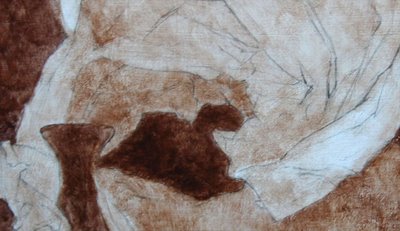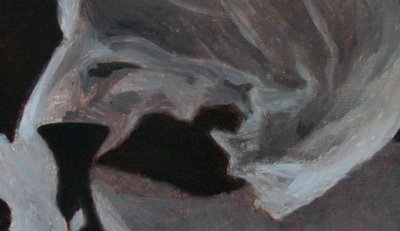Bottle Collection: Overpainting III
 Saturday, May 30, 2009 at 2:43AM
Saturday, May 30, 2009 at 2:43AM full size: 18 x 24 inches
oil on panel
Here are earlier stages of this section:
This first stage is the underpainting and you can still see the graphite line drawing showing through the thin wash underpainting:
Next I did a rough "closed" underpainting -using white instead of the white of the panel. It got more refined than this but still I consider it an underpainting, thinking only in value and using a very limited palette:
Below is the first stage of the overpainting, where I am using a full spectrum of colors, and no black at all, to get a richer, more colorful range of greys. Here I am making what I think of as a "bed layer" - much more refined than the underpainting, but nowhere near the final level of detail. I'm not trying to paint to a finish, I'm just putting down whatever I think will help me in the final stages.
On to the final layers. At this point I am trying to achieve the highest level of finish possible in a very small area of the painting for every session. At a certain point I can see what I need to do to push the realism further, but I have to wait for the layer to dry before I can do more layers:
Below I am working completely in glazes, using honey-consistency glazing medium with just dark, transparent paints, and occasionally bringing a light area just a bit higher. This looks pretty similar to the previous stage, but it represents many more hours of work. This is the final push for the most impact I am capable of achieving with the paint.
I am also continuing to learn how discerning the human eye is, that a tiny whisper of different value or hue between two adjoining shapes makes a clearly discernible edge. I am constantly experimenting with how subtle a difference I can make that will still read as a difference, and describe form. In the shadowy areas of the wax paper we can see a lot of sculpted form and transparency within a very low value range - dark to black, with just little glimmers for highlights.
It's fun to try to emulate that effect, nudging hues and values around in tiny steps to describe the forms.
Reader Comments (10)
Thank you for giving such a clear explanation of the thinking behind your painting. Yu said you used lots of glazes, which colours? and do you use stand oil or another medium mix? wonderful work Sadie. r.
Fascinating how you achieve the level of realism. Thank you for sharing. I learned a lot. Honor
Beautiful as always, Sadie. I so appreciate your explanations of your wonderful technique. You are such a special artist. Thanks much!
Love the deep dark shiny bottle! It has both surface and depth.
Mmm, glazes - is there anything more fun?
I am grooving on all the learning I'm presently learning, but now I really hunger to do some of my own work again, looking at yours. There's just no pleasing me.
Hi Rahina - Thanks for reminding me, I made a new link to my materials post in the bottom of this post, I talk about my paints and mediums there :)
Thank you Honor and Susan!
Spatula I know there must be moments of frustration to be in student mode after learning to make your own work. But I sure wish I did a full time atelier program at some point! Hang in there! :)
Hey Sadie - gorgeous piece of work, girl!
About that dust - have you tried wet sanding?
Cindy, tell me more about wet sanding!!! What is it????
I looked up "wet sanding" on an art forum and found out: apparently you rub linseed oil over the painting using 1200 grit wet/dry sandpaper to get rid of dust embedded in the top layer, and wipe off with a (dust-free) cloth. I'm going to try it in a small area of my painting, will let you know how it goes :)
I love all your work and especially liked to see the stages that you work in. They are so atmospheric and the paper reminds me of clouds and waves.
I thought I was the only person suffering from dust and it drives me crazy! I noticed that glazes seem to attract more dust than less diluted paint, and canvas seems less prone than hardboard (or that may just be me!).
Thank you for both your kind comments Paul! Yeah I thought I was the only one suffering from dust too and then I found a whole thread devoted to the problem on a painting forum. I agree, the smoother and more glazed the painting, the more it acts like a magnet for dust - it's a murphy's law of painting I guess :)